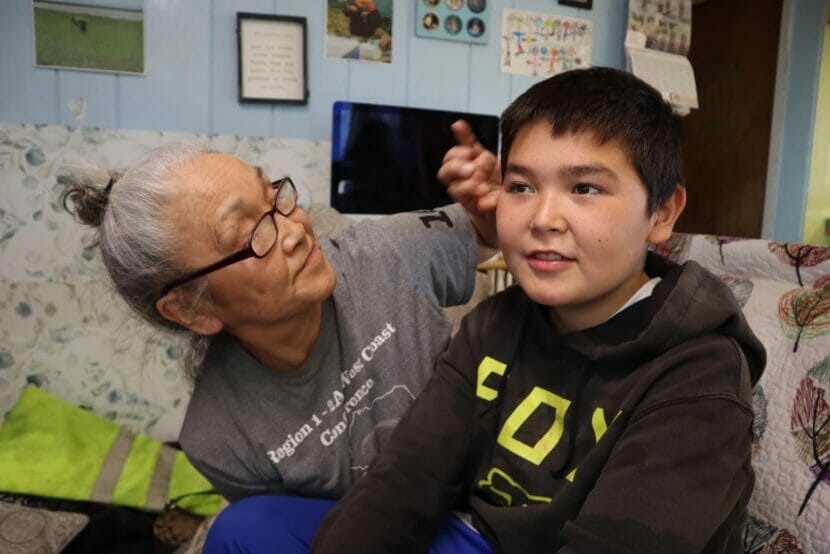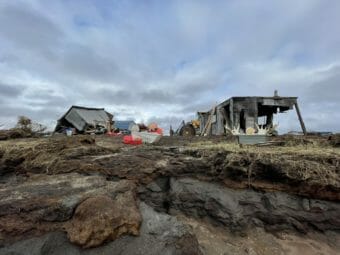
In Hooper Bay and Chevak, kavlakuaraq, also known as blackberries or crowberries, are missing from the tundra.
“Uh, there’s almost next to nothing,” said Victoria Hill, who works for the Hooper Bay Tribal Council. “My dad said he went out there towards back of town and there was maybe scattered all over. Not like a carpet like it used to be; they were just scattered. You had to go far.”
A massive storm in 2022 brought flood waters to this part of Alaska, and the tundra was inundated with salt water for days. Add to that a cold and rainy summer, and Roy Bell said that it’s the perfect recipe for a blackberry crash.
“I noticed that the areas where they flooded, some of the plants, many, like the medicines and the berries, they’ve all gotten bad,” Bell said. And he said that it’s not just the crowberries. Lowbush cranberries are also missing, and many of the medicinal plants he uses don’t look healthy.
“It’s probably the salt water,” Bell said.
In Hooper Bay, Bell’s family and friends in Hooper Bay call him “the botanist.”
When he was very young, his parents and elders discovered that Bell had a knack for understanding and identifying the plants.
“I’m one of the last generations that took that talent test with the Elders, and my talent was the plants,” Bell said.
Now in his fifties, Bell has spent his whole life studying the land and plants that blanket the tundra along Alaska’s Bering Sea coast.
“No mechanics, no boats, no nothing. Just land and plants,” Bell said.
This area has flooded before, but Bell said that previous floods haven’t had nearly the impact on local foods. It’s not just the plants that haven’t returned this year.
“It’s either foxes, or the owls, or the hawks,” Bell said.
Lots of residents are also reporting fewer birds of prey and predators on the landscape. And that may be because those animals haven’t been able to find their own food: mice.
Much of the low lying land that stretches nearly 20 miles from Hooper Bay inland to Chevak was flooded: a catastrophic scenario for a mouse. The tiny rodents store up plant roots for the winter months. Locally it’s called mouse food, and it’s a delicacy out here in Cup’ik country. Mark Ulroan in Chevak said that it’s his favorite.

“They’re called teardrops. We call them utngungssaq and then those long roots, we call it marallaq. So those are the two main ones that we get every year for ingredients, like if we cook our seal soup. At the end of it, we add those.”
Ulroan said that they taste both sweet and nutty and they have a good crunch. But this year he wasn’t able to find any.
“No, nothing. Zero.” Ulroan said. “ I don’t know if there’s gonna be any mouse out there because all that Merbok just drive ‘em up to the high ground, I guess, or kill ‘em.”
Some people haven’t been able to get out on the water since the storm.
Stella Lake lives in a house that overlooks the Ninglikfak River in Chevak. All summer and into fall, she has watched friends and neighbors head out to go catch fish and hunt seal. Her boat motor was submerged in floodwaters for three days after last year’s storm, and efforts to repair it haven’t been successful.

“Here’s a season where boats go for and everybody’s excited to go, like berry picking season, moose hunting season. And I watch the boats. I can see the river here,” Lake said, pointing to her kitchen window. “It gets me emotional. We can’t go. My baby, he loves hunting, and he breaks my heart to listen to him, man. Why can’t we go?”
Lake’s son, 12-year-old Kade, sat next to her on a cozy couch, looking toward the window. “We don’t get to go to our fish camp, or seal hunting, or go to camps, or get eggs, or pick berries, or go moose hunting. We can’t do all of that because our motor’s not fixed,” he said.
Kade said that being out on the land is his favorite thing to do.
This reporting was supported by a grant from the Center for Rural Strategies and from the nonprofit media organization Grist.

